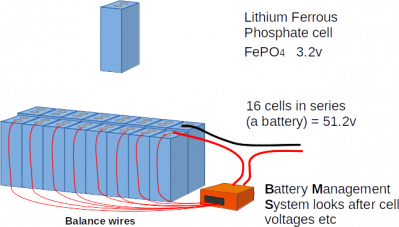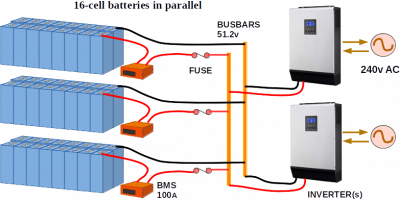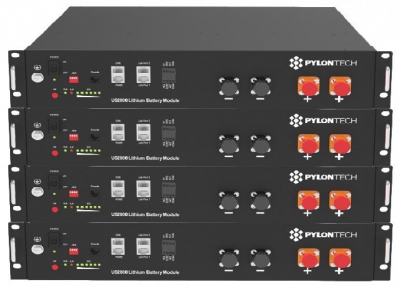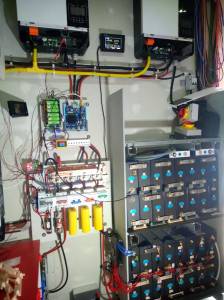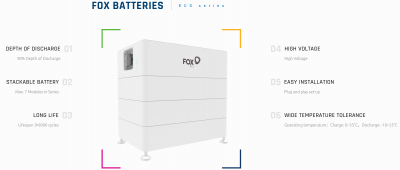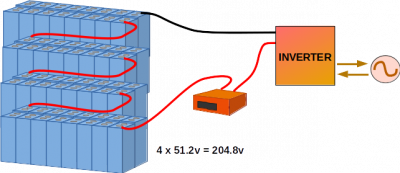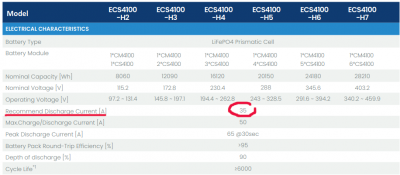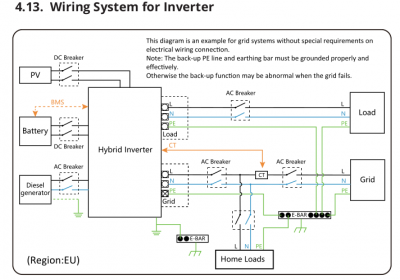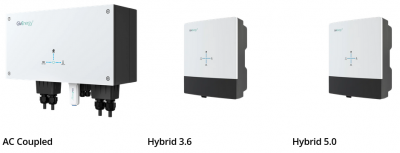Although sub-optimally it only has to power over the peak price period.
House-2 bed partial stone bungalow, 5kW Samsung Gen 6 ASHP (Self install)
6.9 kWp of PV
5kWh DC coupled battery
Blog: https://thegreeningofrosecottage.weebly.com/
Heatpump Stats: http://heatpumpmonitor.org/system/view?id=60
and if you have PV, that should reduce the drain on the battery in daylight hours. Its a complex mix of price v payback time, it will be interesting to crunch the numbers once winter is over to see if it is worth it for me to add another 5kWh battery module.
House-2 bed partial stone bungalow, 5kW Samsung Gen 6 ASHP (Self install)
6.9 kWp of PV
5kWh DC coupled battery
Blog: https://thegreeningofrosecottage.weebly.com/
Heatpump Stats: http://heatpumpmonitor.org/system/view?id=60
Yes @curlykatie it can get quite confusing...
which is presumably why you're here reading this!
I need to pick up two points from what you wrote yesterday:
1: G99 is an Engineering Standard, issued by EREC. It defines issues related to safety, timings, voltages etc.
That's a separate issue to a Planning Application.
The EREC standards for your proposed installation will be checked by UK Power Networks (your DNO).
If required, planning permission would be sought from your Local Planning Authority (LPA).
I have not previously met an LPA which has set a notional limit of 6kW of solar panels as a pre-requisite of local planning conditions.
However, there's no reason why an LPA shouldn't have its own policies as regards energy matters.
Their problem regarding such local policies is that the Deregulation Act (2015) means that they can't enforce those policies on new builds by commercial developers.
That clause doesn't apply to you however. You're not a builder!
2: I have researched the Fox-ESS, and there are a couple of unusual points about its design.
I need to explain those because it means some of the preceding advice you've just received needs to be re-assessed.
Please bear with me whilst I lay out a generic graphical tutorial on storage batteries! 🙂
Most home storage batteries (including those by Fox) are using rectangular Lithium Ferrous Phosphate cells.
These can vary in their capacity from 100Ah to 500Ah.
The cells are most commonly joined together in series to create a battery at a nominal 51.2 volts.
Each battery uses a Battery Management System for protection.
It's a box of electronics which prevents accidental damage to the cells by over/under voltage or over-current.
Typically each battery might be capable of sustaining a charge or discharge current of 100 Amps (plus a margin to allow for sudden surges).
To calculate the power available from such a battery we multiply volts x amps.
50v (ish) x 100A is 5000 Watts.
This rule-of-thumb means that each battery is a 5 kilowatt unit.
If I require 15kW to run my house, then I'm going to need three such batteries.
The majority of householders will have these batteries installed by a professional.
They tend to quote for each battery-box having a capacity of 4kWh (kilowatt-hours).
That's not a great deal, but they need to abide by the Health & Safety at Work Act, which sets a limit on lifting loads greater than 25Kg.
The battery box most commonly installed within the UK over the past 3 years or so is made by Pylontech.
The installer stacks the boxes and uses thick wiring to connect them together in parallel.
Some of us are DIY installers, however. 😎
The UK regulations allow this because the voltages involved are below the 75v where a qualified electrician is required.
We are also not limited to installing 4kW boxes at 25Kg or below.
I usually build larger capacity batteries using individual 280Ah cells.
Those are held on (substantial) steel shelving.
Each 16-cell battery has a nominal 14kWh capacity, and will weigh around 100Kg.
The photo shows steel racking for three such 14kWh batteries.
The lowest one is completed and operational, and the middle one is in the process of being installed.
The top-most shelf was empty when that photo was taken.
To the left is a board with copper busbars and fuses which allow me to safely connect the batteries in parallel.
There are two 5kW inverters on the wall above.
Please don't be worried that all of that equipment is exposed.
It enables me to take photographs when I write responses like this!
The Fox ESS battery system is unusual (but not unique) in that each battery is connected to the others in series (not parallel).
The website for the Fox ECS batteries shows their general layout.
A Master box at the opt of the stack contains all the electronics.
Below this you can have up to seven battery modules.
Note the label "high voltage".
Their battery module layers are connected in series like this:
Whichever model you choose from the Fox ESS range, the recommended internal current for charge/discharge is pretty low, at just 35A for the ranges in the table below
To operate this battery, you must use a corresponding Fox ESS inverter.
It must be able to handle whatever voltage arises from the number of battery modules in the stack.
The 'low costs' are partially explained by the company electing to utilise such low currents.
The internal wiring is much thinner, thereby creating savings on raw copper and connectors!
And the electronics itself uses cheaper components, only capable of handling these low currents.
The limitation for each Fox ESS battery stack is the electronics within the Master unit at the top.
Typically a Fox ESS stack delivers just 4kW.
Adding extra battery (slave) layers doesn't change this; it merely increases the capacity, and hence the amount of time over which it can operate.
If your house requires 15kW, then you'd need to have four such Fox battery stacks.
4 x 4kW = 16kW
plus the Fox inverters required to deliver the 240v AC of course.
There is an obvious advantage for an installer.
He gets repeat business each time the householder needs additional capacity.
You must continue to buy Fox ESS products because that's what you've started with.
You are effectively "locked in" to that technology.
I'm going to pause at this point to allow others to visit the Fox ESS website and comment on what I've just written above.
Save energy... recycle electrons!
@transparent thanks so much for all this info. These companies always have a clever way to tie you in 🙈
Now you've understood a bit more of the background information @curlykatie may I suggest three 'next steps'
1: Stick to devices which are generic.
When an installer recommends a combination of Solar Panel inverter, Storage Battery, heat-pump or whatever, ask if you can choose a mix of different manufacturers.
Check also if there are 'communication cables' between these devices, and whether they are a mandatory part of the system.
A storage battery shouldn't need to rely on the transfer of data to an inverter, for example.
It might provide a 'useful feature', such as reporting the State of Charge (SoC) on the smartphone App for the inverter.
But if that cable isn't present, then both battery and inverter still should be capable of operating.
The most common arrangement is to have a nominal 52v battery consisting of 16 LiFePO4 cells.
The majority of inverters can connect directly to such a battery.
2. Write a (non-technical) priority wish list of what you'd like to achieve.
This might include such things as:
- take most of the electricity from the grid during periods when it is cheaper (known as a Time of Use tariff)
- keep essential devices operating in the event of a power outage (fridge, internet router, lights)
- receive income for supplying electricity back to the grid
Some of these cost a lot more than others, and may not be financially viable at all.
But it will enable us to see what you'd like to achieve.
3. Tell all friends, family and neighbours to visit this forum topic before they start being led towards an installation strategy recommended by an installer!
Save energy... recycle electrons!
@transparent thank you- I will do all of the above!
out of interest, the other system of battery and inverter we were offered was as attached- would this be a more ‘generic’ system?
Thanks for posting that datasheet for the Solax X1-hybrid @curliekatie
The specification for the solar panel input to the inverter looked great until my eye traveled down the page to the section about battery storage
Not only is that outside the 52v-ish we are looking for, but they hadn't even completed its development at the time that PDF was printed.
In similar fashion to the Fox ESS system, this Solax strategy is bespoke to them.
If I was looking for an inverter & storage battery combination which was generic and could support both off-grid and grid-tied operation, then I'd probably start with Sunsynk.
Whilst I don't have hands-on experience with their systems, there are number of features in their favour
- others here on this forum have said they use SunSynk products and speak well of them
- the ENA (Electrical Networks Association) has approved the SunSynk software's capability for limiting grid export across the range of all their products
- when I queried a particularly tricky feature in their design, I received a same-day telephone call from a senior design engineer in South Africa. Impressive!
Here's a generic diagram of the wiring for SunSynk inverters:
Notice that the Home Loads are those mains (240v AC) appliances which you wish to remain 'live' when there's a grid fault.
It's not easy to get that part of the design right, and yet remain within the G98 regulations for grid-connection.
Sunsynk are based in South Africa, but all manufacturing is done in Hong Kong by Global Tech China Ltd.
Their manuals have to cater for many differing 'standards' across the world.
You'll see that the Live wire in the diagram is coloured Black rather than Brown.
That's not a major problem because you'll be employing an installer anyway.
Sunsynk inverters can be connected in parallel to support larger output.
So you're ok to choose a standard household inverter to start with, knowing that a second unit could added later if you discover you need more power.
Save energy... recycle electrons!
Posted by: @transparent
- others here on this forum have said they use SunSynk products and speak well of them
I have mixed feelings about Sunsynk inverters. They do have the benefit of G99/G100 approval but the documentation could be much better and model identification is inconsistent (which has caused me problems as the inverter was installed with an incorrect firmware version, and also another G99 application was made with the wrong model number). There are also software/hardware niggles (~40W draw from the grid while charging batteries when solar input is small, relatively poor conversion efficiencies at low power, Octopus Flux tariff integration still not working, confusing/unintuitive UI and app). Overall they feel like an 'expert friendly' solution.
We have a 9kWh battery and will get another (probably larger) one when we get the heat pump. Our std house consumption is 10kWhs per day, so we cover most of that now in winter use. For the ashp we want to not take any power at the cosy very high peak rate 3hours early evening when you probably need the heating on.
Take the consumption of your ashp in kWh early evening and use that as your target battery size. Ideally use your max consumption but that may not be cost effective long term (nor affordable now) so take a view, say 90%of your maximum usage?
The UK does not need special types of panels that it pure sales talk. All types are sealed and keep rain out. We’ve had ours for 12yrs without regular fuss, rain keeps them clean, but bird netting is an essential not optional extra. Where are you based? You might get some recommendations then. Also try checkatrade
2kW + Growatt & 4kW +Sunnyboy PV on south-facing roof Solar thermal. 9.5kWh Givenergy battery with AC3. MVHR. Vaillant 7kW ASHP (very pleased with it) open system operating on WC
It is important to check the maximum power available from your storage battery.
A typical ASHP might require 30A or more to start up, but less than 10A whilst running.
To deliver the start-up current, the storage battery will need to deliver 30A x 240V = 7200 watts = 7.2kW
A GivEnergy 9.5kWh capacity battery can deliver a maximum 80A at 52v, which is just over 4kW.
So a single battery unit cannot deliver sufficient power to an inverter to satisfy the start-up requirement of the heat-pump.
GivEnergy advertise three inverters which can be used on a single-phase domestic supply
The maximum power available from these inverters (at 240v AC) is 3kW, 3.6kW and 5kW respectively.
So to start-up an ASHP you'd need at least two inverters at 5kW, and two storage batteries.
Alternatively, the ASHP will draw what it requires from the grid when starting up, and use the battery storage whilst actually running.
That assumes the rest of the house is using minimal power of course.
If the ASHP has been commissioned well, then it should just keep ticking over and not turn on/off.
Under those circumstances, a single GivEnergy battery and inverter should be able to power it throughout the expensive Cosy rate of the early evening peak.
[Aside] The GivEnergy 9.5kWh storage battery is the largest option they seem to offer.
As it's rated 52v nominal, it will be using sixteen cells in series.
The capacity for each of those cells is specified in their datasheet as 186Ah.
The ratio of price/capacity for LiFePO4 cells is such that the 280-300Ah range is normally the low-point on the cost curve.
I'll assume that GivEnergy are using the slightly more expensive cells in order to keep down the weight of their battery.
Even so, at 110Kg, it's a 4-man lift when compared against HSE guidance of 25Kg per person. 😲
Save energy... recycle electrons!
Thanks to lots of help from people on this forum, ive eventually landed on a Sunsynk 5kw Hybrid inverter and a 14.3kw Seplos 280L battery, my next purchase will be either another Seplos 280L @14.3kw or sell my Seplos at a loss and buy two 15kw batteries that have built in heaters as my storage batteries are in an unheated area.
the point i am trying to make is that there are alternative options if you can find a competent electrician - my sunsynk and seplos cost around £4k to buy and around £1k to install - another battery would cost around £2.5k - so for around £7.5k i will have close to 30kw of storage capacity. we are all electric and easily use 20+Kw per day in the winter, so i am trying to get all our power bought (and stored) at the offpeak period.
the big question is though, is it really cost effective? im not totally convinced, but its a long term project, we have no intentions of moving, but for me (and not necessarily others) its tied in to not just the cost of electricity, but when it can be bought cheaply. if i can buy in the early hours and then later in the afternoon (Cosy Octopus), then i prob dont need as much storage, but if i can only buy in the morning, then i need bigger storage capacity.
i think economy seven or similar, will be around for quite a while as the power companies want us to use more power when there is little demand and less power when there is greater demand, hence my reasoning for additional storage. i am also lucky in that we have an existing solar panel system paying good rates under the discontinued Feed in Tariff scheme, which has more than paid for itself and is now offsetting the cost of the storage battery installation by around £1k per year (with another guaranteed 15 years).
So if you do have the services of a competent electrician then there is a lot of money to be saved with home battery storage systems by 'doing it yourself', though actually, the only diy aspect is that youre sourcing the materials and the labour!!
- 26 Forums
- 2,418 Topics
- 54.8 K Posts
- 439 Online
- 6,098 Members
Join Us!
Worth Watching
Latest Posts
-
RE: Reliable, easy to use home battery options
On safety and the misinformation implying all lithium b...
By Batpred , 10 minutes ago
-
RE: Octopus Cosy Heat Pump Owners & Discussion Thread
I did not hear back from the tech team. (Assume they ar...
By swwils , 15 minutes ago
-
RE: How to use my Hanchu battery storage for home without it feeding back into the grid?
Hi. My Hanchu battery system is controlled by the (Lux...
By SKD , 2 hours ago
-
RE: Ecodan Pump Issues… Circulation pump turns off when heat pump compressor turns off
Unfortunately it seems to be oversized. I can answer to...
By ASHP-BOBBA , 2 hours ago
-
RE: Installer Fitted 9kW Instead of 11kW Heat Pump and Changed MCS Paperwork - What do I do?
@jamespa thank you again. Apologies I missed you pointi...
By MairiA , 3 hours ago
-
RE: Advice for a novice on Mitsubishi Ecodan 6kW
In the Home Assistant firmware the data points...
By F1p , 14 hours ago
-
RE: GSHP WOES! Midland based engineer recommendations?
@johnbroome if it is not the pressure in the expansion ...
By ASHP-BOBBA , 14 hours ago
-
So I hear the export MPAN that UKPN assigned should be ...
By Batpred , 17 hours ago
-
RE: Recommended home battery inverters + regulatory matters - help requested
From what I read, the Solis has a very long list of err...
By Batpred , 17 hours ago
-
RE: Ideal HP290 14kW ASHP - how to optimise
Roughly this should cost you £250-£300 per peak month a...
By ASHP-BOBBA , 18 hours ago
-
RE: New Daikin 11kW Altherma 3M install - is it working as it should?
@toodles Thank you for your input. As the days have got...
By Synthbuilder , 22 hours ago
-
RE: Fan unit Making terrible noise HELP!!
@gutoffowc Oh no, sorry to hear that, are you in the Ke...
By ASHP-BOBBA , 24 hours ago
-

RE: Sunsynk Whole House Backup Issue
@sheriff-fatman - could you please re-post that in the ...
By Transparent , 1 day ago
-
RE: Running my new Nibe ASHP efficiently
I didn't. I spent a while manually messing around with ...
By jamieheatpumpnew , 1 day ago
-
RE: I’m glad the cold spell is over!
I comparison with the 65kWh used above yesterday was on...
By Judith , 1 day ago
-
RE: Octopus Cosy 12 Heat Pump Regret: Incredibly Loud, Poor Heating & Constant Hum - Help!
I should think so, I thought that pretty much universal...
By JamesPa , 1 day ago
-

RE: Setback savings - fact or fiction?
I'm also inclined to look into how a defrost is actuall...
By cathodeRay , 1 day ago
-
MLCP (Multi-Layer Composite Pipe) for ASHP
@editor nope. The info you reported was sufficient for ...
By iotum , 2 days ago

